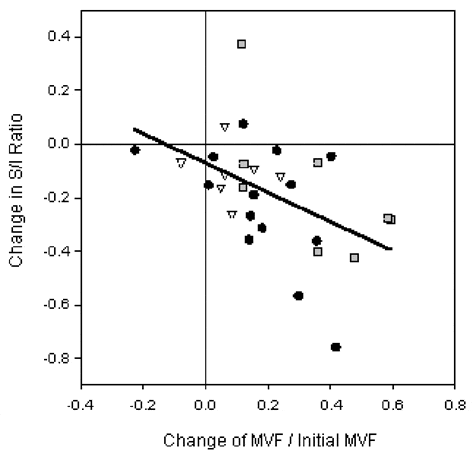When a contracting muscle is rapidly stretched the force increases to about twice that exerted during isometric contraction. We have previously shown that the ratio of the force during stretch to that during isometric contraction increases with age in mice (Phillips et al. 1991) and in women (Phillips et al. 1993); in both cases the aged muscles also exerted less isometric force. We have now investigated in women whether muscle strengthening by exercise is accompanied by a decrease in the ratio of stretch force to isometric force. Three groups of women were studied (post-menopausal non-HRT users, mean age ± S.D. 68.1 ± 6.8 years, N = 8; post-menopausal using HRT, 60.1 ± 7.1 years, N = 14; young, 35.4 ± 6.8 years, N = 7). Subjects were excluded if they had pain or stiffness in the movement of the thumb, any generalised neuromuscular disease, or were taking medications likely to affect muscle function or motivation. The study was approved by the Royal National Orthopaedic Hospital Ethics committee and all subjects gave written informed consent to participate in the study.
During maximum voluntary contractions of adductor pollicis the thumb was suddenly abducted by a pneumatic cylinder pushing a tension transducer against the first metacarpal of the thumb. The transducer moved 6 mm in about 20 ms. Force was measured during the last few milliseconds of the stretch, when the speed of stretch was constant, within the range 0.4-0.6 m s-1 and expressed as a ratio (S/I) to the force immediately before stretch. The mean ± S.E.M. values of S/I in the three groups before training were 2.09 ± 0.07 (non-HRT), 2.10 ± 0.07 (HRT) and 1.94 ± 0.03 (young). After training the values were 1.92 ± 0.09 (non-HRT), 1.87 ± 0.05 (HRT) and 1.83 ± 0.03 (young). The decreases in S/I with training were significant in each group (paired t test, P < 0.04). The differences between the groups in the change of S/I were not significant (ANOVA). Figure 1 shows that, taking all the subjects together, there is a significant correlation between the individual changes with training in isometric force and the changes in S/I (P < 0.01).

